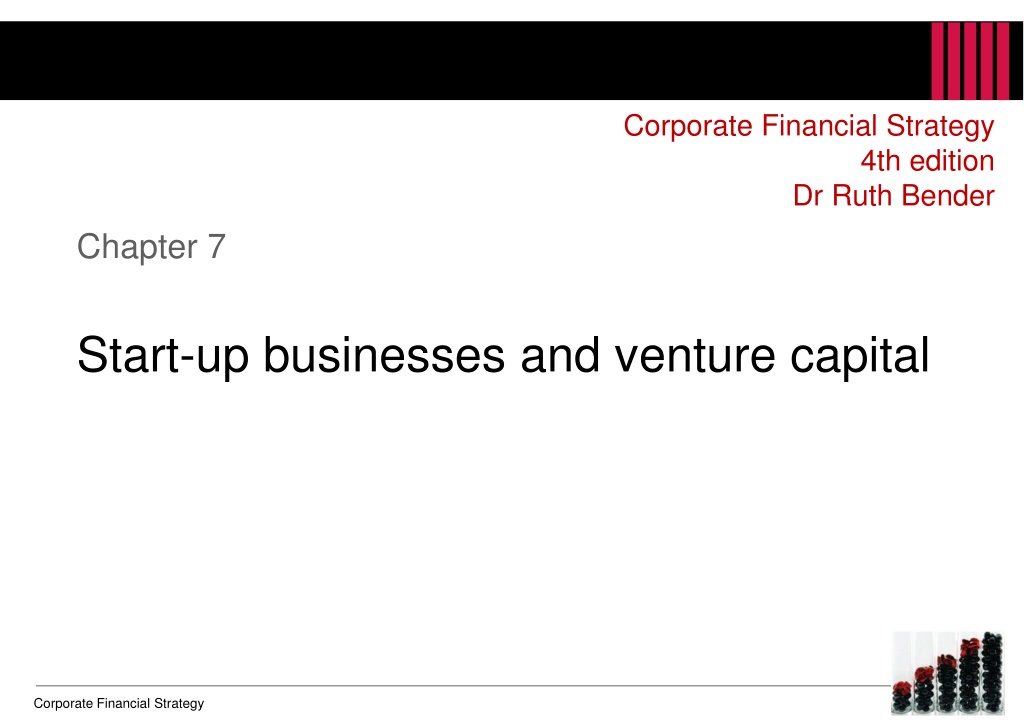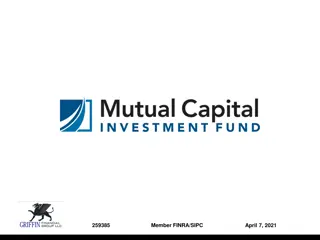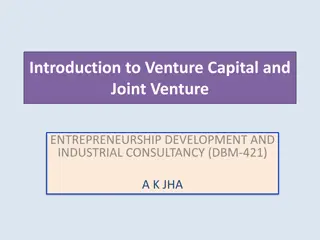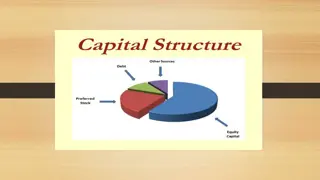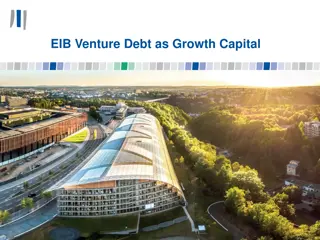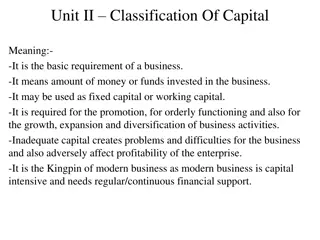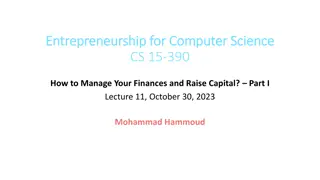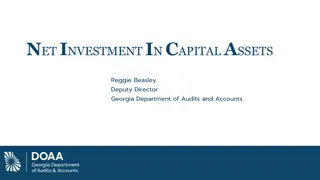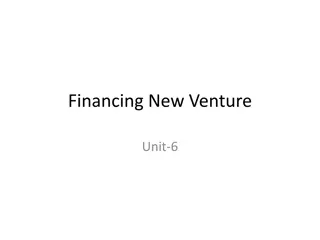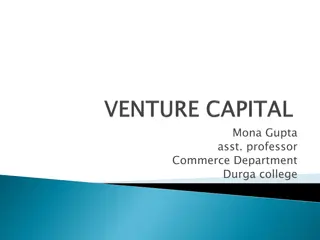Financial Strategies for Start-up Businesses and Venture Capital
Exploring financial strategies, stages in start-up businesses, and accounting for risk in the context of venture capital and early-stage financing. Topics include life cycle models, investor protection clauses, and evaluating growth prospects in high-risk environments.
Download Presentation

Please find below an Image/Link to download the presentation.
The content on the website is provided AS IS for your information and personal use only. It may not be sold, licensed, or shared on other websites without obtaining consent from the author.If you encounter any issues during the download, it is possible that the publisher has removed the file from their server.
You are allowed to download the files provided on this website for personal or commercial use, subject to the condition that they are used lawfully. All files are the property of their respective owners.
The content on the website is provided AS IS for your information and personal use only. It may not be sold, licensed, or shared on other websites without obtaining consent from the author.
E N D
Presentation Transcript
Corporate Financial Strategy 4th edition Dr Ruth Bender Chapter 7 Start-up businesses and venture capital Corporate Financial Strategy
Start-up businesses and venture capital: contents Learning objectives Financial strategy for a start-up business Stages in a start-up Two ways of accounting for the risk Real options Venture capital and business angels Example of corporate venturing Deal terms will include Pre- and post-money Pre- and post-money example Anti-dilution clauses, used in a down round Liquidation preference reduces risk and boosts return 2 Corporate Financial Strategy
Learning objectives 1. Explain how the life cycle model is applied to the start-up stage of a business. 2. Contrast the different ways that companies use to account for high business risk. 3. Prepare or appraise a venture capital term sheet, and explain the potential impact of some common investor protection clauses. 4. Distinguish the various different forms of early-stage financing and comment on their strengths and weaknesses. 3 Corporate Financial Strategy
Financial strategy for a start-up business Very high Business risk Very low Financial risk Source of outside fundingVenture capital Nil pay-out ratio Dividend policy Very high Future growth prospects Very high Price/earnings multiple Nominal or negative Current profitability (eps) Rapidly growing but highly volatile Share price 4 Corporate Financial Strategy
Stages in a start-up Business making R&D spend Production & commercialization Chance to become valuable Prototype and market testing Time The length of each stage depends on the industry and business model The number of successful entities decreases at each stage 5 Corporate Financial Strategy
Two ways of accounting for the risk Probability-adjust cash flows Use a higher discount rate Probability-adjust the cash flows to allow for the changes in probability of success as each stage is reached A high discount rate is applied to the whole project to allow for the overall risk taken on This is more complex mathematically, but has the advantage that certain cash outflows are not discounted at a high rate It is theoretically more appropriate This is more commonly used, because it is simpler, but can be misleading 6 Corporate Financial Strategy
Real options Multi-stage projects Timing flexibility Alternative uses Growth potential Exit options Real options take account of the value inherent in flexibility 7 Corporate Financial Strategy
Venture capital investors and business angels Venture Capital Business Angels Professional investment firms, generally investing funds they have raised as intermediaries rather than their own money Have a portfolio of high-risk investments, often specializing in a particular sector or a specific technology Individuals, often investing their own money Often more informal than professional firms Investment criteria include: favourable impression of the management team, familiarity with the sector, geographical proximity, synergy with own skills Both venture capital firms and business angels are investing with the aim of a high financial return 8 Corporate Financial Strategy
Example of corporate venturing http://www.altassets.net/private-equity-news/by-news-type/deal- news/corporate-vc-bmw-i-ventures-inks-fifth-strategic-investment.html 9 Corporate Financial Strategy
Deal terms will include 1. Company s constitution 2. Shareholders agreement a. Details of the investment and the terms attached to each of the securities e.g. votes, vetoes, covenants, rights on exit, conversion terms b. Drag along and tag along rights c. Pre-emption rights d. Board representation rights 3. Fees 4. Representations and warranties 5. Service contracts 6. Banking agreements 10 Corporate Financial Strategy
Pre- and post-money Pre- money value = Post- money value + Investment 11 Corporate Financial Strategy
Pre- and post-money example Entrepreneur seeks 100,000 in exchange for 10% of the business. This implies that the business as it stands is worth 900,000 (pre-money) And after the investment, it will be worth 1,000,000 (post-money) 100,000 = 10% (Pre-money value + 100,000) 100,000 = (10% x Pre-money value) + 10,000 10% x Pre-money value = 90,000 Pre-money value = 900,000 Post-money value = 900,000 + 100,000 = 1,000,000 12 Corporate Financial Strategy
Anti-dilution clauses, used in a down round If someone else buys more cheaply, you get a refund. Example Original VC investors bought A shares at 100 per share. The A shares will convert into ordinary shares on a disposal, on a 1:1 basis Next stage investors will buy B shares at 50 each Because the A shares are being diluted, the holders of the A shares are issued with new free(ish) shares, to bring their overall cost down to 50 per share. This dilutes the founder s stake. Or, conversion terms may alter to achieve same effect. 13 Corporate Financial Strategy
Liquidation preference reduces risk and boosts return PE company makes sure that on a disposal it gets its money back, or a multiple of its money. Surplus proceeds are then split between parties Example, where VC has put in 200,000 for 50% of the equity. Sales proceeds for equity of 100k, 300k and 1m. 100,000 proceeds 50,000 300,000 proceeds 150,000 1 million proceeds 500,000 No liquid n pref 100,000 250,000 ( 200k plus half of 100k) 300,000 600,000 ( 200k plus half of 800k) 700,000 ( 400k plus half of 600k) 1x LP 100,000 2x LP OR the other shareholders may be credited with their own amounts paid for their shares, in a catch-up exercise before the net proceeds are divided 14 Corporate Financial Strategy
